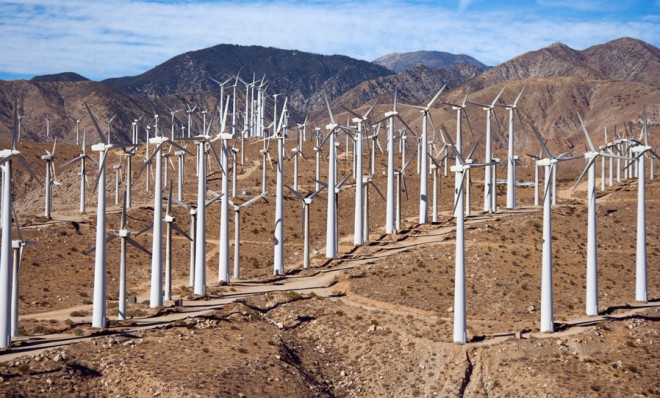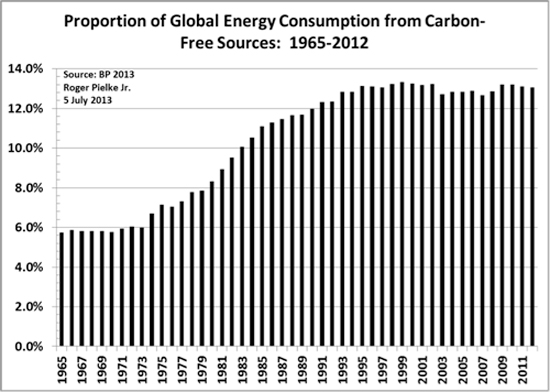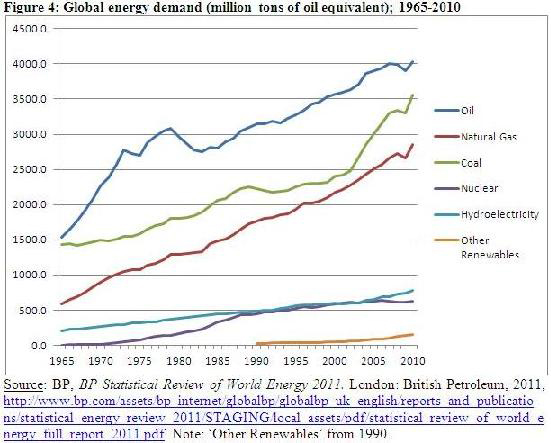Why carbon-free energy is still struggling to make an impact
The global share from solar, wind, and other green sources has barely budged in 15 years

Over the past decade, carbon-free energy production has exploded. In 2012 alone, total global solar-generating capacity ballooned by 43.3 percent, and capacity for wind-generated energy grew by 18.9 percent. The stats and charts seem to imply that carbon-free power is gaining a larger piece of the pie, and will start to whittle away at so-called dirty energy like coal and oil, guiding the world to less carbon output.
But a graph from Roger Pielke Jr., an environmental studies professor at the University of Colorado in Boulder, paints a somewhat different picture. The graph charts the proportion of carbon-free energy consumption to total consumption, and shows that the carbon-free slice hasn't grown for the last 15 years. In fact, the proportion of green-to-dirty energy has shrunk slightly since 1999.

So why are proportions of clean-to-dirty energy stagnating as we install more photovoltaic solar panels and erect more wind farms? One recent influence might be nuclear consumption, which more than tripled between 1982 and 2005, then nose-dived last year when Japan, a world leader in nuclear, cut 89 percent of its capacity following the breakdown of the Fukushima Daiichi plant.
The Week
Escape your echo chamber. Get the facts behind the news, plus analysis from multiple perspectives.

Sign up for The Week's Free Newsletters
From our morning news briefing to a weekly Good News Newsletter, get the best of The Week delivered directly to your inbox.
From our morning news briefing to a weekly Good News Newsletter, get the best of The Week delivered directly to your inbox.
Another might be that so-called dirty energy sources like coal, natural gas and oil, which account for a much larger slice of global energy consumption, have all inched up. Coal consumption rose 2.5 percent in 2012, below the 10-year average of 4.4 percent, but enough to offset gains from squeaky clean sources.
This graph from Real Clear Energy, tells a similar story to Pielke's. Renewable energy is growing, but not as fast as carbon-rich energy sources like coal, which exploded in the early 2000s in step with China's industrial growth.

So what does the data add up to? According to Pielke:
This stagnation provides further evidence that the policies that have been employed to accelerate rates of decarbonization of the global economy have been largely ineffective. [The Breakthrough]
A free daily email with the biggest news stories of the day – and the best features from TheWeek.com
Carmel Lobello is the business editor at TheWeek.com. Previously, she was an editor at DeathandTaxesMag.com.
-
 Homes with great fireplaces
Homes with great fireplacesFeature Featuring a suspended fireplace in Washington and two-sided Parisian fireplace in Florida
-
 Is $140,000 the real poverty line?
Is $140,000 the real poverty line?Feature Financial hardship is wearing Americans down, and the break-even point for many families keeps rising
-
 Film reviews: ‘The Secret Agent’ and ‘Zootopia 2’
Film reviews: ‘The Secret Agent’ and ‘Zootopia 2’Feature A Brazilian man living in a brutal era seeks answers and survival and Judy and Nick fight again for animal justice